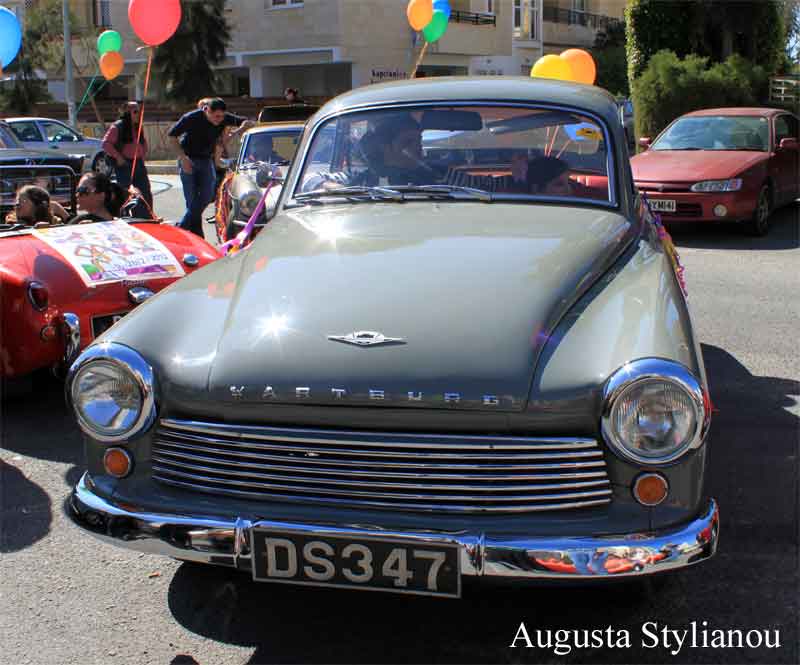.

Wartburg
Photo : Augusta Stylianou Artist
Wartburg was a car marque manufactured in East Germany.
The name "Wartburg" derives from Wartburg Castle on one of the hills overlooking the town of Eisenach where the cars were manufactured.
From the 1950s, Wartburgs had a three-cylinder two-stroke engine with only seven moving parts (three pistons, three connecting rods and one crankshaft).
History
First usage of name
1898 Wartburg
The marque dates back to 1898 when a car made by Automobilwerk Eisenach was named the Wartburgwagen. It consisted of a two-seating cane chair, four mudgards, two headlamps, and a two-cylinder, 765-cc engine. Its top speed was 25 mph. The name was dropped in 1904 when the company changed hands but re-appeared briefly in the early 1930s on the BMW 3/15 DA-3 Wartburg, which was BMW's first sports car.[1][2]
Main usage of name
The name was revived in 1956 by VEB Automobilwerk Eisenach and given to an updated version of their IFA F9 car which had been in production since 1950. The new car had a more powerful version of the three-cylinder two-stroke engine driving the front wheels and a completely new body. By this time, Germany had been divided into two countries (the West and the East) and the Wartburg factory was in the communist East.
Exports to West Germany started in 1958, and by the early 1960s the car was exported to many other countries, including the United Kingdom and United States. Right hand drive models were first made in 1963 and exported to Cyprus, with British buyers being introduced to the car in 1964. However, just 550 examples (450 saloons and 100 estates) were sold in the UK. These were well-equipped two-tone luxury models sold at the same price as a basic Austin Mini, appealing mostly to older people.
The 311 model was manufactured in a number of variations, including pickup, estate, and two-seater roadster.
The engine was enlarged to 992 cc in 1962 and a completely new body was manufactured after 1966. This version was sold as the Wartburg Knight in several countries, including the UK, where the estate model was sold as the Tourist. It remained on sale until 1976, by which time nearly 20,000 had been sold. This marked the end of right-hand drive Wartburgs, but left-hand drive versions continued to be imported to the UK and at least one model was converted to right-hand drive.[1]
Also, in 1966, the gearbox gained synchromesh on all speeds and was designed to freewheel as an engine protection measure, which had the unfortunate side-effect that the car did not benefit from engine braking. Because the engine was a two stroke unit, it relied on the passage of the petrol mixture (A mixture of special two stroke oil and petrol, at a ratio of 1:50) to lubricate the engine. Without the freewheel device, on long down-hill runs the engine could be starved of lubricant and seize unless the throttle was opened briefly from time to time. Nevertheless, it was possible to disengage the freewheel device, recommended to give engine braking in snowy/icy conditions.
The new car, the 353, was known in some export markets as the Wartburg Knight. There are four editions of Wartburg 353:
-Wartburg 353 from 1966
-Wartburg 353W from 1977
-Wartburg 353W from 1983
-Wartburg 353S from 1986
There are three models of Wartburg 353 - Limousine (sedan), Tourist (combi) and Trans (pickup). The 353W modification had a new, round-shaped dashboard and black-coloured grille. It was also fitted with disc brakes on the front axle. The 353S modification featured new rectangular headlights integrated into the grille of a new shape. Moreover, the radiator was moved from behind the engine (353, 353W) to the classic position behind the grille. The engine of the car is two stroke with 50-57 horsepower (depending on the carburettor type). This model has the top speed of 150 km/h but some modified versions can reach 210 km/h (Melkus RS 1000).
In 1988 the new model Wartburg 1.3 replaced the old model 353S, featuring the reliable engine from the Volkswagen Golf.
The new model has four stroke modified engine from Volkswagen with 64 horsepower. The final nail in its coffin was the runup to German reunification during 1990. The introduction of the Deutsche mark (DM) pushed the cost of producing a car up to 20,000 DM. However, it is not likely there would have been a place for Wartburg in the reunified economy in any event, given the amount of pollution it produced. Production ended in April 1991, and the factory was acquired by Opel.
There are still many cars in drivable condition and Wartburg owners' clubs exist throughout Europe. Many Wartburgs are still used as rally racing cars.[3]
vDerivatives
The sports car Melkus RS 1000 used a mid-mounted three-cylinder two-stroke engine from the Wartburg 353.
Models
311, 1956–65
312, 1965
353 (Knight), 1965–88
1.3, 1988–91
From Wikipedia, All text is available under the terms of the GNU Free Documentation License
| Ancient Greece
Science, Technology , Medicine , Warfare, , Biographies , Life , Cities/Places/Maps , Arts , Literature , Philosophy ,Olympics, Mythology , History , Images Medieval Greece / Byzantine Empire Science, Technology, Arts, , Warfare , Literature, Biographies, Icons, History Modern Greece Cities, Islands, Regions, Fauna/Flora ,Biographies , History , Warfare, Science/Technology, Literature, Music , Arts , Film/Actors , Sport , Fashion --- |

